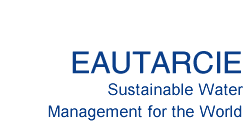
The considerations developed herein are not shared by most water specialists, and must therefore be read discriminately, with critical thinking. This page aims to prompt scientific and public debate on the subject of water sterilization, and contribute new insights on this complex issue. It becomes the readers' responsibility of getting further informed to make their own judgment on the matter.
The text within this page was first published on www.eautarcie.com: in 2003
The original text has been adapted and translated in English by André Leguerrier and was first published on this page at www.eautarcie.org: 2009-06-15
Last update: 2017-04-23


Chlorine and UV Sterilization
The problem with biocide techniques
Chlorine and UV irradiation for sterilizing water are biocide techniques that reflect the prevailing « Pasteurian » school of thought, i.e. hygienics, the purpose of which is to rid us of all that is supposed to make us sick, notably bacteria. By extension, all efforts go into killing off anything that lives in water, with the aid of biocides (substances that kill life). This is the justification for chlorine use, but also of UV lamps. At first hand, these appear to be quite rational approaches since they come under the precautionary principle. Even when in doubt as to the presence of pathogens, many will say: « using biocides can't hurt ». We're looking here at an approach based on postulates that have never really been shown to be valid. Yet, a scientific approach that is free of preconceived notions should only take into account observed experimented facts in laboratory and field tests.
In reality, our immune system has taken tens of thousands of generations to genetically evolve in a dynamic equilibrium with microorganisms that prevail around us and inside our own body, be they pathogenic or not. This equilibrium is a two-way process: our immune system reacts to pathogens through a series of complex processes that we are only just starting to understand while microorganisms modify our immune system in reaction, reinforcing its capacity to combat other similar or closely similar aggressions. In a certain sense, our immune system works like a human organ, like a muscle that is kept in full strength by stimuli or constant exercise. Without this connection, both reactions eventually disappear: we lose our capacity to resist infections and conversely, we persist in combating influences that don't threaten our body. Doctors have a name for the outcome: « allergies ».
There is no doubt that nowadays, systematic elimination of so-called pathogens and untimely vaccination campaigns have, among other factors, helped fluster our immune system into developing allergies that medicine does not control. And that's not even talking about our increased sensitivity to viral disease. Common disinfectants kill bacteria responsible for infectious disease that medicine generally controls well, but they also bring about ideal electrochemical conditions for viral disease. (On this subject, it is instructive to acknowledge results of a largely ignored field of research, medical bioelectronics. [1]) On the other hand, viral disease is not well controlled by medical practice. To sum it up, disinfection eliminates microorganisms that we can easily resist, while at the same time making us more vulnerable to those that we can't. This is where the conventional approach falters.
Another weakness of these biocide techniques is that they kill indiscriminately, like pesticides in agriculture. They kill inoffensive microorganisms as well as useful ones, even indispensable ones. Generalized use of these techniques brings about graver and graver unbalances in our immediate and long-term environment.
Joseph Országh published several papers on this matter between 1991 and 1994, among which an article that has been translated, titled « Some Physicochemical Aspects of Bio-electronic Coordinates ».
Chlorine
Bacteria in water
To guarantee water's microbial purity in centralized conveyance systems, the use of a chemical disinfectant like chlorine seems inevitable. Bacteria and other microbes spontaneously develop in water and fix themselves on conduit and storage tank surfaces as a biofilm. Even if the vast majority of these bacteria are harmless to man, small portions are of the same family as those that thrive in the body of those afflicted with certain infectious diseases. This will normally lead to relate cause and effect, between absorption of water containing reputedly pathogenic bacteria and the appearance of infectious disease. However, such a correlation is far from being so simple. The obvious question already existed in Pasteur's time: « Are bacteria the cause or the consequence of disease? »
Many observations have shown that absorption of these bacteria, even in substantial quantities does not necessarily lead to illness, just as illness can appear without having been preceded by the absorption of suspected contaminated water. The appearance of infectious disease is a phenomenon that results from a combination of circumstances within and without the human body [2]. Contrary to conventional wisdom, we believe that the dominating factor is not the quality of water consumed, but the general state of a person's immune system.
The precautionary principle would dictate however that it is best to consume bacteria-free water. This is the origin of Pasteur-influenced hygienics, which postulates that from the moment bacteria are eliminated from water – by chemical disinfection for example – all is well. By extrapolation, we will exert all efforts to kill off all life in water, with the help of biocides. From such a perspective, chlorine is considered to constitute a feature of hygienics. But in reality, chlorine is a toxic biocide with many side effects that no one almost ever talks about.
Even though World Health Organization specialists are perfectly conscious of these, notably the undesirable effects of chemical disinfection (of potable water), the subject is rarely treated in publications of any sort. Yet, specialists rightly know that the decision to disinfect water (or not) is based on an estimated balance of risks. Chlorination eliminates immediate risks linked to reputedly pathogenic bacteria, but in so doing, the water consumer is exposed to other types of health problems. Unfortunately, because it takes so long for chemical disinfectants to reveal their harm, it is very difficult to establish a cause and effect relation between some viral or degenerative diseases and prolonged use (even externally) of chlorinated water.
Historically, when man began the domestication of animals, he was confronted with new bacteria. The immune system eventually adapted to this situation. Interestingly, the immune system evolved differently between the populations of different continents, such as the classic example of Pre-Columbian American populations who were extremely vulnerable to the diseases imported from Europe. Nowadays, with the thousands of known synthetic molecules, our immune system is often unable to cope, leading to inappropriate reactions : allergies.
Organo-chlorinated compounds
Toxic organo-chlorinated compounds are often mentioned as a chlorination by-product. Even without resorting to chemical analyses, anyone can detect the presence of organo-chlorinated compounds in drinking water. After disinfecting initially pure water, the smell is that of chlorine, and nothing else. It has a pungent smell that brings to mind iodine as sold in drugstores as an antiseptic. Some mains water (less pure at the outset) develops a different odour: that resembling chloroform, a disinfectant used in hospitals. When the smell of chloroform appears, you can be certain that there are other organo-chlorinated compounds present, some of them very toxic.
The toxic effect of these is only noteworthy when the initial water contains enough organic impurities (bacteria, humic particles) before disinfection. When the initial water contains little of these substances, organo-chlorinated compounds are hardly produced, in fact negligible, and are therefore harmless to one's health. The real risk is to be found elsewhere: in water's electrochemical properties.
Chlorine's oxidative character - Bioelectronics of Vincent (BEV) elements
Even those who know nothing of bioelectronics observe the unfavourable effects of chlorine in drinking water. Bioelectronics is a multidisciplinary science situated at the crossroads of electrochemistry, thermodynamics, biology and medicine. It is based on four basic postulates.
- First postulate: Any electronic charge disruption (by ionization, dissolution, transfer or displacement) brought upon an aqueous medium modifies water's properties as an active solvent, which properties can be measured with properly selected electrodes. These electrodes will only detect the nature of the modifications affecting the water itself, and not that of the solutes contained in the water.
- Second postulate: As independent variables, the quantified proton and electron transfers (respectively measured as pH and rH2) define a two-dimensional space in which every point corresponds to a precise state of the water medium.
- Third postulate: To each state characterized by a certain level of proton and electron transfers (pH and rH2) can be associated a multitude of situations, each corresponding to a different electric charge density and mobility.
- Fourth postulate: The maximum dissipation speed of the chemical energy stored in a living water medium is proportional to the square of the potential redox, and inversely proportional to the water's electric resistivity.
Chlorine's bactericide effect is tied to its oxidative character. When you put an oxidizing substance in water, water will tend to capture available electrons. Thus, water's properties become modified. This translates into a measurable electric potential increase, for example of inert metal (like platinum or gold) that has been immersed in the said water. An oxidant's dissolution means a reduction of water's electron activity, which is quantified as rH2.
There is a great similarity between acid-base reactions (pH) and oxidation-reduction reactions (rH2). The dissolution of an acid in water increases proton activity, which reduces water's pH. In contrast, bases that capture protons reduce proton activity and increase the pH. Similarly, the dissolution of a reducing agent in water increases electron activity (since it is an electron provider) whereas oxidants act the other way around. Electron activity is characterized by analogous pH and rH2 scales. The following table resumes the likeness between both types of charged particle exchanges (protons, electrons).
Unfortunately, the rH2 variable![]() is not taken into account during physicochemical analyses of water. Yet it should be, as each type of microorganism (viruses, bacteria, fungi) can only develop within a given pH and rH2 range.
is not taken into account during physicochemical analyses of water. Yet it should be, as each type of microorganism (viruses, bacteria, fungi) can only develop within a given pH and rH2 range.
Graphs (called Vincent diagrams![]() ) that correlate rH2 values with respect to pH values can help map the specific range of existence of any bacteria or virus. Outside those ranges, microorganisms will die [3].
) that correlate rH2 values with respect to pH values can help map the specific range of existence of any bacteria or virus. Outside those ranges, microorganisms will die [3].
My personal contribution to bioelectronics is limited to its electrochemical aspects and excludes all medical or biological concerns. In my publications on the subject, I sometimes quote work done by others in order to highlight bioelectronics' other possible applications.
Scientific literature that deals with bioelectronics acknowledges that most infectious disease bacteria grow in a neutral to lightly acid or alkaline medium (pH) and a reductive medium (rH2). In comparison, viruses prefer an oxidative and lightly alkaline medium. Chlorine disinfection will therefore be harmful to bacteria, but will generate a favourable electrochemical environment for viruses. Regular and prolonged absorption of disinfected water having weak electron activity (i.e. high rH2) progressively modifies blood's redox properties and sets the ground for a whole series of diseases. This is also true of disinfected water used externally.
Louis-Claude Vincent's work has shown that a healthy person's blood has an rH2 around 21. A person in whom a cancer is incubating has an rH2 level above 28. The person afflicted with irreversible cancer has an rH2 blood level above 32 with a slightly alkaline pH.
These last readings are exactly the values measured in water disinfected by chlorination.
It's obvious that ingesting a few glasses of chlorinated water will not provoke illness. However, prolonged consumption of, and bathing in such water – for years on end – impoverishes the body's electron content and progressively increases blood's rH2 value. Thousands of clinical observations have shown that there is a net correlation between alterations to blood's rH2 value and the appearance of some cancers, viral diseases and allergies.
Those who practice bioelectronics consider the rH2 as an important criterion![]() to define water quality.
to define water quality.
The bioelectronic alteration of our body is not conditioned exclusively by chlorinated water absorption. Other factors such as one's diet or lifestyle can also influence. Nevertheless, continuous use and absorption of water that has been disinfected with chlorine can be suspected of promoting long-term health problems.
In this regard, it would be wise to enhance legal potable water standards to guarantee its harmlessness. This is the reason many scientists propose the notion of biocompatible water (i.e. good to drink) as complementary to legally potable water. These ideas are discussed on the biocompatible water page.
Considering the above discussion on water chlorination and its impact on one's health, it is reasonable to adopt a view that is altogether different from conventional water distribution companies and proponents.
UV treatment
The purpose of UV water sterilization is to kill the last bacteria that may have escaped filtration. The bactericidal efficiency of UV lamps requires that at each use, a certain quantity of water must be wasted to compensate for the flow of « non-disinfected » water during start-up of the lamp. However, the problem with UV lamps lies elsewhere. Observations made on plants watered with sterilized water tend to indicate a negative impact on health.
This is one of those many health issues on which scientists disagree, each side standing their ground based on valid arguments. In my opinion, scientific differences are more philosophical in nature than technical. For now, respective stands are irreconcilable.
UV's effect on water's structure
UV irradiation of water seems inoffensive because it only kills those microorganisms living in water. We forget that UV's photons contain more energy than does visible light's. As such, this isn't too serious. Yet, though water is transparent in the entire visible light spectrum, it is completely opaque in the UV spectrum. This means that the entirety of photons penetrating water stays there: it is absorbed. Thus, all irradiated light energy is absorbed by water molecules, to be then transformed into intramolecular kinetic energy, i.e. vibration and rotation. Physicists say that « vibration and rotation energy levels in water molecules are in an excited state ».
In water's case, hydrogen bonds become deeply disrupted. Thanks to normal intramolecular bonds, polymeric clusters are always present in water. Even though they are fleetingly brief in space and time, these clusters have remarkably constant concentrations in time. To be biocompatible, an aqueous medium must be organized in polymeric structures bonded with hydrogen molecules. Such an organization is ensured by, among other things, the presence of ions (dissolved mineral salts) in water. It is also modified by other dissolved substances.
One can obviously look beyond such discussions on water irradiation impacts [4] . It's probably the more pragmatic stand. Based on the experience of thousands of households using the PLUVALOR rainwater harvesting system, 10-micron filtering does not pose a health problem for non-food purposes, where sterile water is not required. For drinking water, (2 to 3 litres maximum per person per day), a microfiltration or reverse osmosis system will provide water quality that complies with the strictest standards. The installation of a UV lamp to disinfect water produced by a reverse osmosis unit is absolutely useless. In fact, the membrane (i.e. the filtering element), with its 10/1000 micron porosity not only filters out bacteria, but also viruses. Water produced by a reverse osmosis unit is already sterile. And the bacteria that may appear as a biofilm in the unit’s pressure tank are inoffensive.
Yet in many countries, laws go against such environmental logic. For example in France, bureaucrats can go so far as to impose UV sterilization of harvested rainwater that is simply used to feed flush toilets. My opinion on this issue: it is the government scientists' responsibility to properly evaluate the relevance of such measures compared with the costs and health risks also involved with using chlorinated water.
[4]
The scientific perspective is concerned with what happens to the photon energy absorbed. Absorption actually takes place at a molecular vibration level. The excited molecules can fleetingly re-emit photons before returning to their « normal » vibratory state. The re-emitted photons can have a wavelength that is identical or superior to that of UV. Observations have shown that there is no visible phosphorescence following UV irradiation of pure water. The emission mostly occurs in the infrared range where particle spin levels are modified. This may result in a slight temperature increase. One could surmise that because the energy quickly relapses, the only permanent effect of UV photon absorption would be similar to that of a very small heating element. That is the conclusion of some scientists who propound UV irradiation.
Yet for other scientists, in the time span between photon absorption and re-emittance of other photons, water's hydrogen bonds are affected. This is where physiological effects probably occur on the polymer clusters of water. Even if these clusters are fleetingly brief, their respective proportions in water are remarkably constant. That UV irradiation can modify these proportions is a potential source of concern. This debate lies in the highly contested domain of « water memory »: does it or doesn't it have memory? In Raman spectroscopy, polymer clusters are detected and their proportions are measured. Unfortunately, to my knowledge, modifications to water's Raman spectrum subsequent to UV irradiation have not been the object of systematic research. Doubt thus persists. Some argue on the fact that water remains the same, before and after irradiation, except for a very slight temperature increase.
In reality, UV irradiation modifies the number of vibratory levels of water molecules, leading to the destruction of water's polymer structures.
Up to now, for reasons that are in no way scientific, there has been persistent resistance to do any research on the real health impacts of drinking irradiated water. Vendors of UV irradiation equipment argue that toxicity to the human body « is unproven ». However, in France and Spain, it has been observed that seed germination and plant development are negatively affected by water’s exposure to irradiation, from UV lights as well as from cathode-ray tube screens. Surprisingly, the germination rate of seeds is much lower in irradiated water. Similarly, cut flowers in a vase of irradiated water quickly wilt, whereas in non-irradiated water, flowers stay fresh for many days. Proponents of UV irradiation argue that it is impossible to extrapolate the result of these experiments on plants to man. This may be true, but then, why not experiment irradiated water on animals to prove its harmlessness beyond doubt?
The life-support medium is water, and evidently, it is sensitive to weakly energized irradiation. Experiments performed on chicken embryos exposed to GSM ultra-short wave irradiation (mobile phones) have provided instructive data. UV photons contain many times more energy than ultra-short waves. It would therefore be surprising that UV irradiation has no physiological effects.
The supramolecular polymer clusters in fact determine water’s biological properties. We do not know exactly what effect irradiated water has on the human body, but by extrapolating from irradiation's effects on living matter, the precautionary principle should dictate that is it preferable not to irradiate water for human consumption.
Finally, most scientists still argue that UV irradiation leaves no chemical traces in water, as opposed to chemical disinfection. The only effect is a very slight temperature increase (a fraction of a degree) due to the dissipation of the absorbed photon energy. My personal question: if this be the case, why does the germination rate of seeds drop dramatically in irradiated water, and why do cut flowers wilt prematurely in a beaker of irradiated water?
To continue reading, go to page on Implementing PLUVALOR




